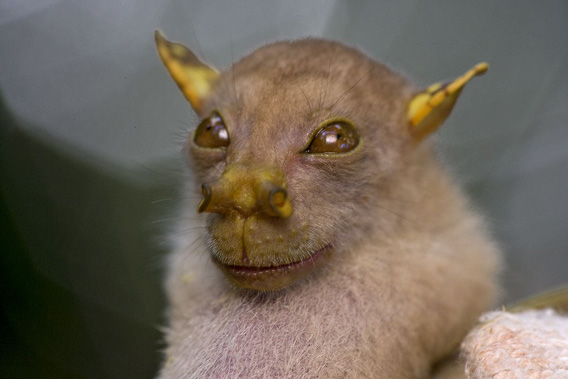
This fruit bat has been seen prior to this expedition, but remains undescribed. Although scientists have yet to name the species, the popular media has already dubbed it the ‘Yoda bat’ given its resemblance to the Jedi master character from the Star Wars series. Fruit bats are vital to rainforests as they disperse seeds. Photo © Piotr Naskrecki/iLCP.
A 2009 expedition to Papua New Guinea proves once again that the island-nation is as diverse in life as it is in human cultures. It took researchers with Conservation International (CI) and the local Institute for Biological Research (IBR) just two months to uncover a startling 200 new species: averaging more than 3 a day in the remote Nakanai Mountains and Muller Range rising from the island of New Britain, a part of Papua New Guinea. Half of the new species were spiders, but the team also found two new mammals, nine new plants, two dozen frogs, and multitude of insects. Most surprising was the discovery of at least two species so unique that they are likely to be assigned their own genus.
“There’s no question that the discoveries we made in both surveys are incredibly significant both for the large numbers of new species recorded, and the new genera identified,” said Leeanne Alonso, head of CI’s Rapid Assessment Program (RAP) which sends scientists on brief expeditions into biodiverse areas that have been largely unsearched by researchers. Since its first expedition in 1990, RAP has uncovered over 700 new species.
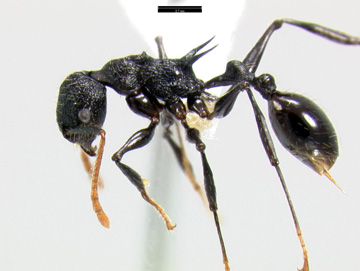 This spiny ant from the Muller Range likely represents a new genus. Found in the canopy of a fallen tree at mid-elevation (1600m), RAP entomologist Andrea Lucky suspects that these ants survive high in the trees. This discovery proves that much remains to be learned about the arboreal ants of the region. Photo: © Andrea Lucky. |
On this expedition in the Nakanai Mountains experts found a unique high-altitude mouse with a half white, half black tail. With no close relatives to date identified, researchers are creating a new genus for the tiny rodent.
Entomologists also uncovered a variety of new ant species, including an ant sporting remarkable spins on its back. Researchers believe the new ant, of which they only found two individuals, actually lives high in the forest canopy. Like the mouse, the new ant is so different that researchers think it belongs to its own genus: DNA studies on species are underway.
Another notable discovery was a two centimeter long frog from the ceratobatrachid family. The new tiny amphibian was surprising because until now these type of frogs were only known from the Solomon Islands.
Researchers were especially attracted to the Nakanai Mountains and Muller range given that both have been nominated for UNESCO World Heritage status by the federal government’s Department of Environment and Conservation.
“We hope that news of these amazing new species will bolster the nomination of these spectacular environments for World Heritage status,” said expedition team leader Stephen Richards.
 This tiny frog belongs to group previously known only from the Solomon Islands, making its discovery on New Britain a complete surprise. The frog calls in the late afternoon, especially after drenching rainfall, a common occurrence. © CI/photo by Stephen Richards |
Once protected by its remoteness and wild geography, Papua New Guinea’s people and species are facing new threats, as well as new opportunities. Logging and palm oil industries are putting pressure on tribes and the governments to clear forests for income, while big development projects, such as mines, imperil ecosystems. For now, however, Papua New Guinea remains one of the most untouched nations in the eastern hemisphere.
“[These new species] should serve as a cautionary message about how much we still don’t know about Earth’s still hidden secrets and important natural resources, which we can only preserve with coordinated, long-term management,” said Alonso.
Collaborating with CI was A Rocha International (ARI), a Christian-oriented NGO devoted to conservation.
“As Christians, we believe we are called to care for creation and ensure that life on Earth is protected and respected, no matter how seemingly insignificant a particular species might appear to be,” said Sir Ghillean Prance, chair of the A Rocha International Board. “We also believe that we have a responsibility to help the poorest members of society, whose needs very often go hand in hand with natural resources, as it is usually the poorest people who live most closely to nature and depend on it for their daily needs.”
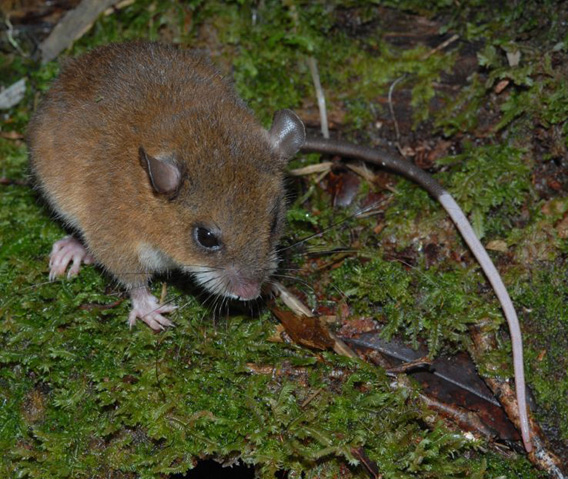
Although this new mouse species resembles the prehensile-tailed tree mice of New Guinea, researchers believe this mountain mouse has no close relatives, representing a new genus. © CI/photo by Stephen Richards .
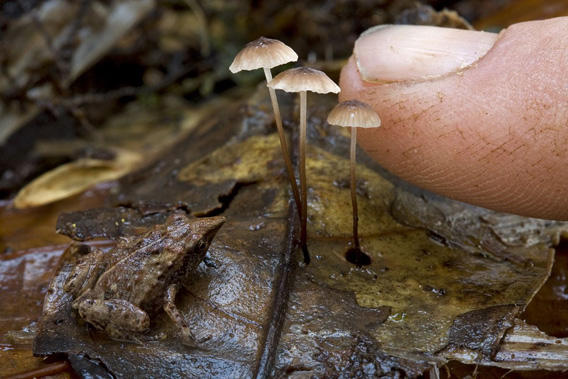
Another new frog found on the expedition. Although this one is unmistakable due to its nose. Incredibly small, this frog was found by following its cricket-like call. Photo © Piotr Naskrecki, Conservation International.
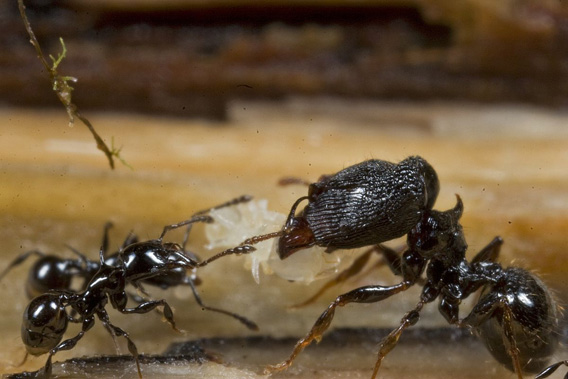
More new ant species: the big ant, known as a ‘major’ meets workers. Workers bring food to the majors who crush it with their giant jaws.
Photo: © Andrea Lucky.
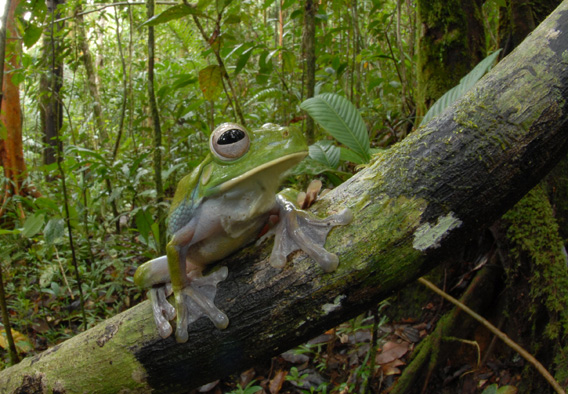
DNA tests will determine whether or not this is a new species of frog, but scientists believe it is likely. Researchers found it living 30 meters up in the trees. © CI/photo by Stephen Richards .
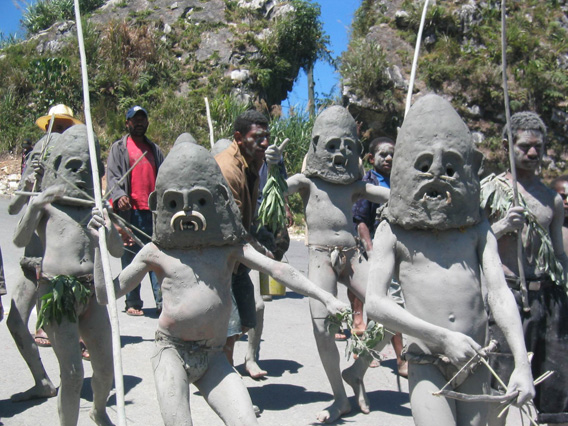
Scientists enjoyed highland dancers celebrating Papua New Guinea’s independence day. Photo: © Leeanne Alonso, Conservation International.
Related articles
Stunning monkey discovered in the Colombian Amazon
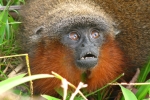
(08/11/2010) While the Amazon is being whittled away on all sides by logging, agriculture, roads, cattle ranching, mining, oil and gas exploration, today’s announcement of a new monkey species proves that the world’s greatest tropical rainforest still has many surprises to reveal. Scientists with the National University of Colombia and support from Conservation International (CI) have announced the discovery of a new monkey in the journal Primate Conservation on the Colombian border with Peru and Ecuador. The new species is a titi monkey, dubbed the Caquetá titi ( Callicebus caquetensis). However, the announcement comes with deep concern as researchers say it is likely the new species is already Critically Endangered due to a small population living in an area undergoing rapid deforestation for agriculture.
Papua New Guinea strips communal land rights protections, opening door to big business

(06/30/2010) On May 28th the parliament in Papua New Guinea passed a sweeping amendment that protects resource corporations from any litigation related to environmental destruction, labor laws, and landowner abuse. All issues related to the environment would now be decided by the government with no possibility of later lawsuits. Uniquely in the world, over 90 percent of land in Papua New Guinea is owned by clan or communally, not be the government. However this new amendment drastically undercuts Papua New Guinea’s landowners from taking legislative action before or after environmental damage is done. Essentially it places all environmental safeguards with the Environment and Conservation Minister.
Close to a billion species: ocean exploration reveals shocking diversity of tiny marine life

(04/19/2010) Biologists worldwide may have to start re-evaluating their estimates of the number of species on Earth, since expeditions documenting the oceans’ tiniest species have revealed shocking diversity: in the tens of millions of species, at least, and according to one researcher “closer to a billion”. Fourteen field projects sent out by the Census of Marine Life focused on the oceans’ smallest inhabitants: microbes, zooplankton, and tiny burrowing species inhabiting the deep sea bed. What they found was astounding.
Indonesia to target New Guinea for agricultural expansion
(02/22/2010) Indonesia will target its last frontier — its territory on New Guinea — as it seeks to become a major agricultural exporter, reports the AFP.
Photos: New tropical frog undergoes remarkable transformation
(02/01/2010) Nature never runs out of surprises. Exploring Sudest Island off of Papua New Guinea, researchers discovered a new species of frog that drastically changes its appearance from juvenile to adulthood, a transformation that has never been seen in another frog.The new species, named Oreophryne ezra, is shiny black with bright yellow spots. Yet when it matures, the frog becomes rose-colored and even its eyes change from black to blue.
New species everywhere in Papua New Guinea’s ‘lost’ volcano
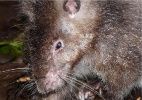
(09/07/2009) A five week expedition into a remote extinct volcano has uncovered a treasure trove of new species in Papua New Guinea, including what may be the world’s largest rat, a fanged frog, and a grunting fish. In all the expedition estimates it may have found around forty species unknown to science. The expedition was undertaken by a BBC film crew and scientists in January. Local trackers led them into the unexplored jungle, hidden beneath the Bosavi volcano’s 2,800 meter summit. Six months prior to arrival, fields of spinach and sweet potato were planted to feed the expedition in such a remote area.
Photos: hundreds of new species discovered in Himalayan region, threatened by climate change

(08/10/2009) Scientists from a variety of organizations have found over 350 new species in the Eastern Himalayas, including a flying frog, the world’s smallest deer, and a gecko which has walked the earth for 100-million-years, according to a new report by the World Wildlife Fund (WWF). The report, entitled Where World’s Collide, warns that these rare biological treasures, as well as numerous other species, are threatened in the Eastern Himalayas by climate change.
Photos: treasure trove of new species discovered in Ecuador

(06/16/2009) Near the once-contentious border of Ecuador and Peru in the mountainous forests of the Cordillera del Condor, scientists from Conservation International (CI) conducted a Rapid Assessment Program (RAP), uncovering what they believe are several new species, including four amphibians, one lizard, and seven insects. The team focused on the Upper Nanharitza River Basin, which has been geologically isolated from the rest of the Andes, giving it broad potential for new species.
Photos: top 10 species discovered in 2008

(05/22/2009) Scientists documented 18,516 previously unknown species in 2007, report researchers from the International Institute for Species Exploration at Arizona State University, who also unveiled the “top 10 new species” described in 2008. The “top 10” species include a pea-sized seahorse, caffeine-free coffee, bacteria that live in hairspray, a tiny snake, a two foot long insect from Malaysia, a fossilized specimen of the oldest known live-bearing vertebrate, a snail whose shell twists around four axes, a ghost slug from Wales, a deep blue damselfish, and a palm that flowers itself to death.
Approximately 200 new frogs discovered in Madagascar threatened by political instability

(05/11/2009) Amid the amphibian extinction crisis—where amphibians worldwide are disappearing due to habitat loss, pollution, and a devastating fungal epidemic—the Spanish Scientific Research Council (CSIC) has announced some good news. In a survey of the island-nation of Madagascar they have identified between 129 and 221 new species of frogs. The discovery of so many new species nearly doubles the island’s total number of frogs.
Photos of new frogs discovered in Colombia
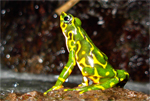
(02/03/2009) Ten undescribed species of amphibians — including nine frog and one salamander — have been discovered in the mountains of Colombia, report scientists from Conservation International (CI). The “new” amphibians included spiky-skinned, orange-legged rain frog, three poison dart frogs and three glass frogs, named for their transparent skin. The amphibians were discovered during a recent Rapid Assessment Program (RAP) expedition in the Tacarcuna area of the Darien, near the border with Panama.
12 new species of frogs discovered in India

(02/03/2009) A dozen previously unknown species of frogs have been discovered in the forests of Western Ghats according to a paper published in latest issue of Zoological Journal of Linnean Society, London. The 12 species have been identified following a revision of the Philautus genus and are the result of ten years of field study in Kerala, Tamil Nadu, Karnataka. Goa, Maharashtra, and part of Gujarat, in the Western Ghats. The Western Ghats are considered a global biodiversity hotspot for their species richness and the threats the mountain range faces.
